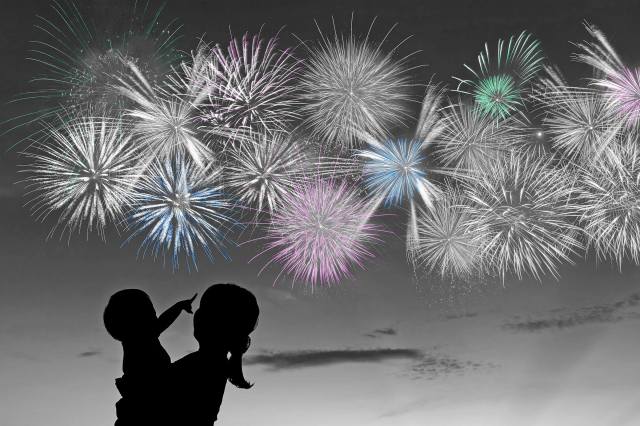
The World’s First Fireworks Were Developed in China
The precursors to fireworks were simple bamboo sticks thrown into bonfires, which popped loudly when the air inside the bamboo’s chambers heated up and burst. Chinese villagers were using these rudimentary fireworks to celebrate the new year and ward off nefarious spirits by the second century BCE.
Legend suggests that around 1000 CE, Chinese alchemists stumbled upon the formula for gunpowder and applied the discovery to weapons of war. During the Song dynasty (960 to 1276 CE), people began packing gunpowder into paper tubes and lighting them on fire. They also created bunches of firecrackers tied together so that the initial explosion would start a chain reaction.

Marco Polo Reportedly Brought Fireworks to Europe
When Marco Polo returned to Venice from Asia at the end of the 13th century, he brought back a number of curious items. Among them were fireworks, which he reportedly introduced, or at least helped popularize, in the region that is now Italy. During the Renaissance, metallurgists in Florence created fireworks displays during religious holidays, Romans set them off after the elections of popes, and firework shows were popular theater at court in Ferrara. Italian craftspeople developed colored fireworks in the 1830s, and the tradition lives on. Two of the largest American fireworks companies today, Zambelli and Fireworks by Grucci, were founded by Italian immigrants in the 19th century.

Firework Shells Contain Six Simple Components
In pyrotechnic parlance, a shell is a bundle of explosive materials that forms the nucleus of a firework. They’re usually packaged in a paper tube in a specific order. In the center of the shell are tiny cubes of chemicals, called stars; other compounds to create special effects; a bursting charge; and an internal time fuse connected to a packet of black powder called the lifting charge. A fuse leads from the lifting charge to the exterior of the shell.
When the fuse is lit, it eventually ignites the lifting charge, sending the shell into the sky. As it rises, the flame burns through the internal time fuse to the bursting charge, which explodes the whole shell in a shower of colored sparks.
More Interesting Reads

There Would Be No Fireworks Without Chemistry
Specifically, the chemistry that creates black powder, also known as gunpowder. The standard mix for the black powder used in modern fireworks hasn’t changed much in the last few centuries: It’s a combination of 75% potassium nitrate (saltpeter), 15% charcoal, and 10% sulfur. When ignited, the sulfur melts over the charcoal and saltpeter, which combust and cause the explosion.
There is chemistry in fireworks colors as well. Specific chemical compounds in the stars release different wavelengths of light when ignited. Strontium salts create red fireworks, barium salts make green, and sodium salts create yellow. Blue, made by copper salts, is the hardest color to achieve; too much copper and the explosions are too dark to be seen at night, while too little copper makes the fireworks appear plain white.

Fourth of July Fireworks Displays Are Almost as Old as the United States
The Second Continental Congress declared the American colonies’ freedom from British control on July 2, 1776, a day that Massachusetts delegate John Adams called “the most memorable Epocha, in the History of America.” In a letter to his wife Abigail, Adams continued: “It ought to be solemnized with Pomp and Parade, with Shews, Games, Sports, Guns, Bells, Bonfires and Illuminations from one End of this Continent to the other from this Time forward forever more.” On July 4, 1777 (the first anniversary of Congress’ adoption of the final Declaration of Independence), that’s exactly what happened, though it wasn’t all Adams’ idea. Fireworks had been a part of public patriotic festivals for centuries by that time.

Fireworks Helped Inspire the Anti-Noise Movement
While fireworks are a visual spectacle, they also produce a lot of noise. Social reformers concerned about the din’s effect on people’s health and safety formed the Society for the Suppression of Unnecessary Noise in New York City in December 1906. Led by physician Julia Barnett Rice, the group convinced lawmakers to regulate steamboat whistles, train noise, and fireworks. In an essay titled “Our Barbarous Fourth,” Rice condemned the cacophony of ceaseless firecrackers and “every noisy device from the tin trumpet to the dangerous pistol.” The society eventually convinced city officials to establish noise-free quiet zones around hospitals and facilities serving poor residents.











